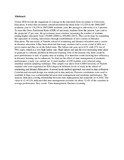Transactional distance as a predictor of perceived learner satisfaction in distance learning courses: a case study of bachelor of education arts program, university of Nairobi, Kenya
Abstract
There is a long history of study and recognition of the critical role of interaction in supporting and even defining
distance education. Interaction has been identified as key to the success of distance learning. It is key in fostering,
supporting and engaging in the learning process. Moore (1989) posits that the physical distance that exists in e-learning
courses between the teacher and the students may result in a psychological and communicational gap between them.
Such a gap will often impede the ability of the teacher and his or her students to achieve the desired level of
understanding among them. In the light of this, teachers and students participating in distance-learning courses will
generally require ―special‖ behavioral patterns, which are designed to overcome the communication gaps resulting from
the transactional distance. This study examined three key distances experienced by students enrolled in distance
learning courses as predictors of perceived learner satisfaction. Through a survey analysis, the study sought to answer 3
key questions - to what extent is Leaner-Leaner Transactional Distance (LLTD) predictive of students‘ perceived
satisfaction (SPS) with a Distance Education (DE) course? Is Learner-Teacher Transactional Distance (LTTD) a
predictor of students perceived satisfaction with the DE course? To what extent does Learner-Content Transactional
Distance (LCTD) serve as a predictor of perceived learner satisfaction with a DE course? Subjects constituted of a
random sample of 168 students enrolled for a Bachelor of education program in 2013 at the University of Nairobi,
Kenya. A survey questionnaire measured the predictive constructs of the study namely, Learner-Learner Transactional
Distance (LLTD), Learner-Teacher Transactional Distance (LTTD) and Learner-Content Transactional Distance (LCTD).
Students‘ perceived satisfaction (SPS) was measured by use of a ten item Likert scale instrument. Results of the study
indicated the three variables were key predictors of students‘ perceived satisfaction with DE courses.
Citation
Mbwesa, J. K. (2014). Transactional Distance as a Predictor of Perceived Learner Satisfaction in Distance Learning Courses: A Case Study of Bachelor of Education Arts Program, University of Nairobi, Kenya. Journal of Education and Training Studies, 2(2), 176-188.Publisher
University of Nairobi
Collections
- Faculty of Education (FEd) [1042]
Related items
Showing items related by title, author, creator and subject.
-
Perception of distance education learners towards the quality of learner support services: a case of Bachelor of Education (Arts) by distance mode at the University of Nairobi
Kariuki, Simon K (University of Nairobi, Kenya, 2010)Distance learning is becoming an increasingly popular way of studying, and most universities now provide courses using this delivery mode. Distance education has created enormous opportunities for the expansion of educational ... -
The effect of time management on academic performance of Distance learners: A case of the University of Nairobi Distance Learners.
Rugendo C, John; Ndiritu, Anne; Kidombo, Harriet; Mbwesa, Joyce (University of Nairobi,School of Education, 2013)Vision 2030 reveals the magnitude of wastage in the transition from secondary to University Education. It notes that secondary school enrolment has risen from 112,229 in the 2006/2007 academic year to 118,239 in 2007/2008 ... -
The effect of time management on academic performance of distance learners: A case of the University of Nairobi distance learners
Nderitu, Ann (2013)Vision 2030 reveals the magnitude of wastage in the transition from secondary to University Education. It notes that secondary school enrolment has risen from 112,229 in the 2006/2007 academic year to 118,239 in 2007/2008 ...


